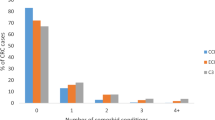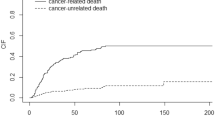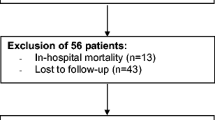Abstract
Purpose
Colorectal cancer survivors are at risk of dying from other causes including comorbidities and second malignancies. This study was undertaken to identify demographic and clinical predictors of cancer-specific and competing causes of mortality.
Methods
The crude probabilities of mortality attributed to colorectal cancer, other cancers, and non-cancer causes were estimated for 19,415 residents of Queensland, Australia, who were diagnosed with a first primary colorectal cancer between 1996 and 2007 when aged 20–79 years and survived at least 2 months, with follow-up to the end of 2009. Multivariate competing risk analysis was used to analyze covariate effects on the cumulative probability of the different mortality types.
Results
Five-year cumulative probabilities of colorectal cancer, other cancers, and non-cancer mortality were 29.4 % (95 % CI 29.3, 30.7), 2.0 % (95 % CI 1.8, 2.2), and 5.7 % (95 % CI 5.3, 6.0), respectively. Factors associated with an increased risk of non-cancer mortality included older age, male gender, unmarried status, localized disease, first primary colon cancers, no surgery, and the presence of comorbidities. Apart from diagnosis of a metachronous secondary cancer, being older, unmarried, or in blue-collar occupations were independent predictors of increased mortality due to other cancers.
Conclusions
A better understanding of the role of competing events and the ability to predict risk of such events have the potential to translate into more effective individualized strategies for colorectal cancer management. The control of comorbidities and reducing cancer risk through clinical management and lifestyle changes should be an important and attainable goal for CRC survivors.



Similar content being viewed by others
References
Gellad ZF, Provenzale D (2010) Colorectal cancer: national and international perspective on the burden of disease and public health impact. Gastroenterology 138:2177–2190
Ferlay J, Shin HR, Bray F, Forman D, Mathers C, Parkin DM (2010) GLOBOCAN 2008: Cancer incidence and mortality worldwide. IARC, Lyon. Available from: http://globcan.iarc.fr/. Accessed 20 May 2011
Cunningham D, Atkin W, Lenz H-J et al (2010) Colorectal cancer. Lancet 375:1030–1047
Mariotto AB, Rowland JH, Ries LA, Scoppa S, Feuer EJ (2007) Multiple cancer prevalence: a growing challenge in long-term survivorship. Cancer Epidemiol Biomarkers Prev 16:566–571
Campo RA, Rowland JH, Irwin ML, Nathan PC, Gritz ER, Kinney AY. (2011) Cancer prevention after cancer: changing the paradigm—a report from the American society of preventive oncology. Cancer Epidemiol Biomarkers Prev
Curtis RE, Freedman DM, Ron E et al (2006) New Malignancies among cancer survivors: SEER cancer registries, 1973–2000: National Cancer Institute, Bethesda, NIH Publ. No. 05-5302. Available from: http://seer.cancer.gov/publications/mpmono/. Accesed 10 Nov 2011
Dasgupta P, Youlden DY, Baade PD (2012) Multiple primary cancers among colorectal cancer survivors in Queensland, Australia, 1996–2007. Cancer Causes Control 23:1387–1398
Zamboni BA, Yothers G, Choi M et al (2010) Conditional survival and the choice of conditioning set for patients with colon cancer: an analysis of NSABP trials C-03 through C-07. J Clin Oncol 28:2544–2548
Lee WS, Lee JN, Choi S, Jung M, Baek JH, Lee WK (2010) Multiple primary malignancies involving colorectal cancer-clinical characteristics and prognosis with reference to surveillance. Langenbecks Arch Surg 395:359–364
Andersen PK, Geskus RB, de Witte T, Putter H (2012) Competing risks in epidemiology: possibilities and pitfalls. Int J Epidemiol 41:861–870
Dignam JJ, Zhang Q, Kocherginsky M (2012) The use and interpretation of competing risks regression models. Clin Cancer Res 18:2301–2308
Gooley TA, Leisenring W, Crowley J, Storer BE (1999) Estimation of failure probabilities in the presence of competing risks: new representations of old estimators. Stat Med 18:695–706
Fine JP, Gray RJ (1999) A proportional hazards model for the subdistribution of a competing risk. J Am Stat Assoc 94:496–509
Hanrahan EO, Gonzalez-Angulo AM, Giordano SH et al (2007) Overall survival and cause-specific mortality of patients with stage T1a, bN0M0 breast Carcinoma. J Clin Oncol 25:4952–4960
Mell LK, Dignam JJ, Salama JK et al (2010) Predictors of competing mortality in advanced head and neck cancer. J Clin Oncol 28:15–20
Rose BS, Jeong JH, Nath SK, Lu SM, Mell LK (2011) Population-based study of competing mortality in head and neck cancer. J Clin Oncol 29:3503–3509
Pintile M (2006) Competing risks: a practical perspective. Wiley, New york
Data Services Unit QH (2006) Queensland hospital admitted patient data collection (QHAPDC) manual 2006–2007. Available from: http://www.health.qld.gov.au/hic/qhapdc2006/QHAPDC_Manual_0607.pdf. Accessed 03 January 2012
Queensland Cancer Registry, Cancer Council Queensland (2011) Cancer in Queensland: incidence, mortality, survival and prevalence, 1982 to 2008
Grulich AE, Swerdlow AJ, Silva IDS, Beral V (1995) Is the apparent rise in cancer mortality in the elderly real? analysis of changes in certification and coding of cause of death in England and Wales, 1970–1990. Int J Cancer 63:164–168
International Agency for Research on Cancer, International Association of Cancer Registries, European Network of Cancer Regstries (2005) International rules for multiple primary cancers. Asian Pac J Cancer Prev 6:104–106
National Centre for Classification in Health (NCCH). (2006) International statistical classification of diseases and related health problems, 10th revision, Australian Modification (ICD-10-AM). 5th ed. Faculty of Health Sciences, University of Sydney, Sydney
Krnjacki LJ, Baade PD, Lynch BM, Aitken JF (2008) Reliability of collecting colorectal cancer stage information from pathology reports and general practitioners in Queensland. Aust N Z J Publ Health 32:378–382
Baade PD, Dasgupta P, Aitken JF, Turrell G (2011) Distance to the closest radiotherapy facility and survival after a diagnosis of rectal cancer in Queensland. Med J Aust 195:350–354
Cramb SM, Garvey G, Valery PC, Williamson JD, Baade PD (2012) The first year counts: cancer survival among Indigenous and non-Indigenous Queenslanders, 1997–2006. Med J Aust 196:270–274
Coviello V, Boggess M (2004) Cumulative incidence estimation in the presence of competing risks. Stat J 4:103–112
Pepe MS, Mori M (1993) Kaplan—meier, marginal or conditional probability curves in summarizing competing risks failure time data? Stat Med 12:737–751
Wolbers M, Koller MT, Witteman JC, Steyerberg EW (2009) Prognostic models with competing risks: methods and application to coronary risk prediction. Epidemiology 20:555–561
Kim HT (2007) Cumulative incidence in competing risks data and competing risks regression analysis. Clin Cancer Res 13:559–565
Cleves MA, Gutierrez RG, Gould MW, Marchenko YV (2010) An introduction to survival analysis using Stata, 3 (Revised ed) edn. Stata Press, College Station
Lee M, Cronin KA, Gail MH, Feuer EJ (2012) Predicting the absolute risk of dying from colorectal cancer and from other causes using population-based cancer registry data. Stat Med 31:489–500
Koo JH, Leong RW (2010) Sex differences in epidemiological, clinical and pathological characteristics of colorectal cancer. J Gastroenterol Hepatol 25:33–42
Pal SK, Hurria A (2010) Impact of age, sex, and comorbidity on cancer therapy and disease progression. J Clin Oncol 28:4086–4093
Australian Institute of Health and Welfare (2012) Australia’s health 2012 Canberra: AIHW. Australia’s Health series no. 13. Cat.no; AUS 156. Available from: http://www.aihw.gov.au/publication-detail/?id=10737422172&tab=3. Accessed 23 July 2012
Pinquart M, Duberstein PR (2010) Associations of social networks with cancer mortality: a meta-analysis. Crit Rev Oncol Hematol 75:122–137
Aarts MJ, Lemmens VE, Louwman MW, Kunst AE, Coebergh JW (2010) Socioeconomic status and changing inequalities in colorectal cancer? A review of the associations with risk, treatment and outcome. Eur J Cancer 46:2681–2695
Frederiksen BL, Osler M, Harling H, Ladelund S, Jorgensen T (2009) Do patient characteristics, disease, or treatment explain social inequality in survival from colorectal cancer? Soc Sci Med 69:1107–1115
Cancer Council Australia Colonoscopy Survelliance Working Party (2011) Clinical practice guidelines for survelliance colonoscopy- in adenoma follow up; following curative resection of colorectal cancer; and for cancer surveillance in inflammatory bowel disease. Cancer Council Australia, Sydney. Available from: http://wiki.cancer.org.au/australia/Guidelines:Colorectal_cancer/Colonoscopy_surveillance. Accessed 29 December 2011
Young JM, Leong DC, Armstrong K et al (2007) Concordance with national guidelines for colorectal cancer care in New South Wales: a population-based patterns of care study. Med J Aust 186:292–295
Lee L, Cheung WY, Atkinson E, Krzyzanowska MK (2011) Impact of comorbidity on chemotherapy use and outcomes in solid tumors: a systematic review. J Clin Oncol 29:106–117
Koroukian SM, Bakaki PM, Schluchter MD, Owusu C (2011) Treatment and survival patterns in relation to multimorbidity in patients with locoregional breast and colorectal cancer. J Geriatr Oncol 2:200–208
Carmack CL, Basen-Engquist K, Gritz ER (2011) Survivors at higher risk for adverse late outcomes due to psychosocial and behavioral risk factors. Cancer Epidemiol Biomarkers Prev 20:2068–2077
Hawkes AL, Lynch BM, Youlden DR, Owen N, Aitken JF (2008) Health behaviors of Australian colorectal cancer survivors, compared with noncancer population controls. Support Care Cancer 16:1097–1104
Rock CL, Doyle C, Demark-Wahnefried W et al (2012) Nutrition and physical activity guidelines for cancer survivors. CA Cancer J Clin 62:242–274
Kosinski L, Habr-Gama A, Ludwig K, Perez R (2012) Shifting concepts in rectal cancer management. CA Cancer J Clin 62:173–202
Mell LK, Jeong J-H, Nichols MA, Polite BN, Weichselbaum RR, Chmura SJ (2010) Predictors of competing mortality in early breast cancer. Cancer 116:5365–5373
German RR, Fink AK, Heron M et al (2011) The accuracy of cancer mortality statistics based on death certificates in the United States. Cancer Epidemiol 35:126–131
Acknowledgments
The authors wish to thank staff working in the Queensland Cancer registry and Queensland Health for providing us with the data extracts used in this analysis. This study was supported by a grant from the (Australian) National Health and Medical Research Council (NHMRC) (ID561700). Associate Professor Peter Baade is supported by an NHMRC Career Development Fellowship (ID1005334).
Author information
Authors and Affiliations
Corresponding author
Electronic supplementary material
Below is the link to the electronic supplementary material.
Rights and permissions
About this article
Cite this article
Dasgupta, P., Youlden, D.R. & Baade, P.D. An analysis of competing mortality risks among colorectal cancer survivors in Queensland, 1996–2009. Cancer Causes Control 24, 897–909 (2013). https://doi.org/10.1007/s10552-013-0166-4
Received:
Accepted:
Published:
Issue Date:
DOI: https://doi.org/10.1007/s10552-013-0166-4




